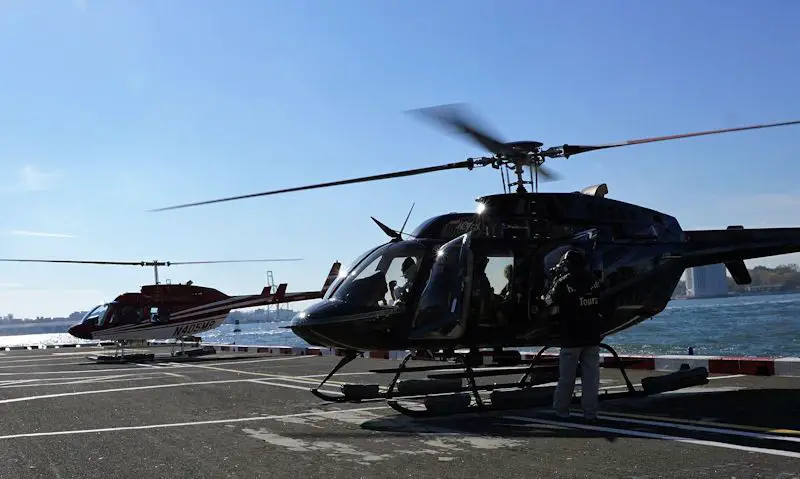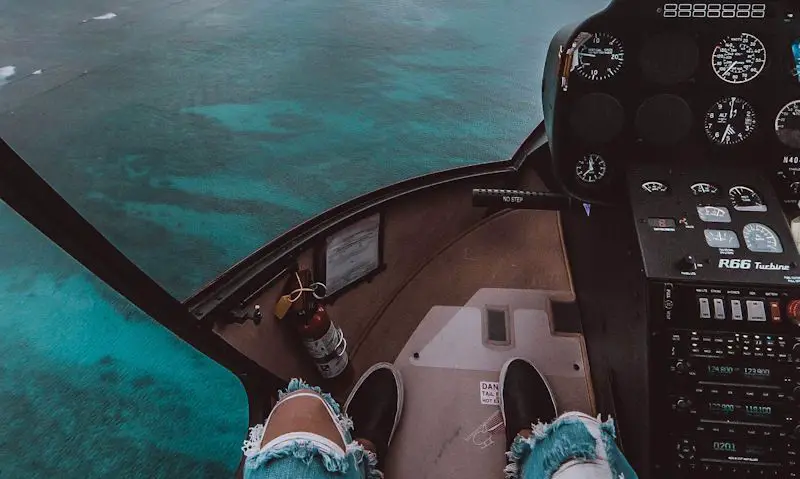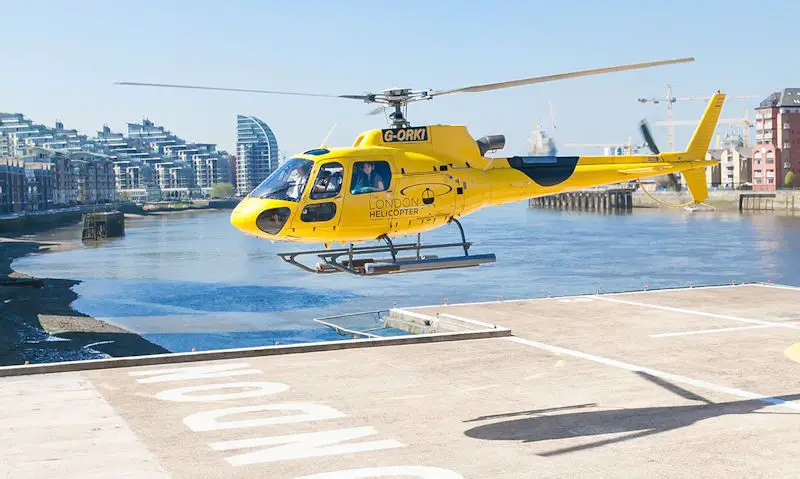22 Tips for First Time helicopter ride
Flying in a helicopter for the first time can by both an exciting and nerve-wrecking time, so I hope to ease those concerns before you fly by offering 22 tips for first timers.
So you're taking a first time helicopter ride and you need a few tips; no problem as I hope to offer all in know with experience. Well first you'll start with a briefing, you'll then go on to know what to wear, what not to take and what you need to bring with you on the helicopter flight.
Scary yet an exciting time taking your first helicopter ride, with nothing to worry about as all services tend to have exceptional safety records.
In the lead up to your flight, this is where you'll have the most burning questions that are not often answered elsewhere, so I hope to change that.
I haven't listed tips by priority, but I've done my best to answer frequently asked questions that flying in a helicopter for the first time will make you ask.
So here it is, my 22 tips for people flying in a helicopter for the first time.
1) Safety briefing comes first
Once you've arrived at the helicopter centre for your flight, it won't happen right away but soon you or your group will be called up for a safety briefing.
It won't be possible to fly until you've had the safety briefing; outlining how to fasten and unfasten your seatbelt, in case of an emergency well exiting the chopper promptly.
The helicopter may be on the tarmac so you could be given a quick demonstration if possible, though it might not be possible during busy times.
2) Wear closed, rubber sole laced shoes
I've recently surveyed up to one hundred helicopter tour companies, and they all say the same thing; all passengers should wear closed shoes such as smart shoes or sneakers.
So do away with sandals or slip on shoes for your flight; well reverting to shoes that need tying up with a lace.
Shoes should be flat with a rubber sole, well a small heel should be fine; providing you can climb up into the helicopter without risking injury.
3) No carry-on's will be allowed
If you're arriving at the heli centre in the car, then be sure to leave all accessories you don't need in the car.
Only bring essentials such as sunglasses or a camera; well leaving your wallet or purse, rucksacks and bags behind.
When traveling by car it would be easy to leave accessories behind; though if you're heading out from a hotel or hostel, then leave them all behind in your room.
4) Pilot will determine where you sit
People are basically taking a helicopter ride for the thrill of flying in a helicopter for the first time, or are big helicopter fanatics - so it could be disappointing to where you sit.
Where you end up sitting in the helicopter will be decided by weight and balances; meaning the weight of all passengers and pilot would be distributed.
So that might mean you won't get the front seat, or even a window seat. Generally speaking, the lightest person in the group will get the rear middle seat.
5) Inside helicopter will feel like car travel
Travel to the helicopter heliport in car or public transport and you may get a feel of how the temperature will be in the helicopter well in flight - though it could be a little colder.
In the winter the weather can be chilly in the helicopter as it is in the car; well the hot weather on the ground will reflect how it could be in the air.
So dress accordingly, wear layered clothing in the cold months well dressing down in the hot summer months.
6) Clothing should be comfortable
There's no stepping out of a helicopter in flight once you're up in the air, so its vital you wear your must comfortable clothing.
That would mean avoiding unfamiliar clothing, big puffy winter jackets or skirts and pants you can't keep up or down.
The helicopter company will want you to enjoy the experience, so therefore will want you to be comfortable during the duration of the ride.
7) Pilot will answer questions or concerns
In leading up to your first helicopter flight ever, it can be a daunting task for anywhere who has a little concern about flying.
To overcome the fear of flying in a helicopter, try to forget about it for now and remember; once you've spoken to the helicopter pilot before the flight, you should settle.
All aspects of the helicopter ride, the helicopter itself and the flight path you're taking will be answered by the pilot or ground staff - so if you have questions, just ask.
8) Height, Weight will be taken
Less about the height, but if you're too tall then you could be measured as there is a height limitation when taking a helicopter ride.
However, what's more important is all passengers must be weighed. So if you're a little embarrassed about your weight, know that it must be shared.
There's no getting around it either, the helicopter company will weigh you. You can't be too heavy either, as all passengers must be 300lb (21st.) or less. If you're overweight, they could charge you for another seat.
9) Passengers wear noise-canceling headsets
Part of safety briefing and demonstration could include how to use the headset well in flight. Thankfully all you need to do as the passenger is fit them over your head.
During the flight the pilot can talk to you or you can ask questions. Though the pilot may cut you off briefly as he or she will need to respond to air traffic or control promptly.
Headsets do fit comfortable and are usually standard; you'll end up with a generic pair or you could end up wearing a trendy BOSE pair. Did you know each head set could cost up to £600, or $766 or so.
10) Seatbelt will fasten over shoulders
You should learn about this in your safety briefing as the helicopter company show a demonstration how to fasten and remove your seatbelt.
It will involve fastening the buckle around your waist, before then fastening an additional seatbelt over your shoulders and between your head, locking it on the seatbelt you should have fasten first around your waist.
In knowing how the seatbelt works is vital for two reasons; first, so you know how to remove it if in case of an emergency; secondly, if you take a helicopter landing tour, passengers can take care of it themselves with no ground crew in sight.
11) Request front seat or pay
Assuming you could end up in the front seat could mean you end up disappointed. Know that front seats could be reserved for paying passengers as a add-on service.
So therefore you need to get ahead of the crowd by phoning up the helicopter company to require about sitting in the front seat if possible.
In doing so you may have to pay to reserve the seat, though you could end up sitting in the middle seat in the back if you're small and lightweight.
12) Middle seat passenger will see less
Talking about the back middle seat; OK sure its probably best position for people who are a little afraid of heights, so you should be sat here to avoid the views.
However, if you're looking forward to seeing the amazing views out of the passenger side windows - your views will be obstructed if you are unlucky enough to sit here.
It won't be possible to look out and down, well your vision is focused more on looking out directly, rather than down. Saying that, the passenger on either side of you could also go towards making things hard to see past them.
13) Hats could be rejected
Do not under any circumstances wear a hat to your helicopter ride. It may be chilly, you may need a hat, but helicopter services usually advise against it.
That's largely to do with it being a loose accessory, so therefore there's an element of danger with the rotors blades above.
Instead you might want to call the service to be advised. For example, cold climate countries or cold seasons allow warn hats, so it may or may not be allowed.
14) Cell phone to flight mode
Again, this is another topic that will be discussed during your safety briefing; and that's to turn your cell phones to flight mode.
The helicopter service may go one better and watch you or do it themselves on your phone if you don't no how to.
If you won't be using your phone but instead taking in the enjoyment of the helicopter ride only, then turn it off - but remember you might want to take pictures using your phone.
15) Motion sickness will be triggered
Are you adverse to motion sickness; then I would suggest contacting the helicopter service to see if they can offer advice.
Often helicopter models can have rear facing seats, and like traveling backwards in a train, this can trigger motion sickness - so its imperative you don't face backwards.
Facing forwards doesn't prevent motion sickness, but it could help a little. I will say if you get it bad, then don't take a helicopter ride - it will make things worse.
16) Flying with strangers
When taking a helicopter ride as one; know that you won't get the helicopter to yourself, as all seats will need to be taken in order for the helicopter flight to go ahead.
For you, this could mean sharing a flight with up 5 strangers. Though if you're lucky enough you could end up in the front seat so a group can sit together.
If taking a helicopter ride on your own, you could do all you can to take the pressure off by making small talk - by requesting a front seat or paying for it.
17) Sunglasses are a must
Well the wearing of sunglasses are not a must for those of us who don't like to wear them, those that need sunglasses when driving should bring a pair along.
If you don't wear sunglasses ever and don't intend too, then this could change during a helicopter ride, as the sun is often unavoidable.
And what this could mean for you is; the sun will always be in your eyes for the length of the flight; ruining it for you if you can't see.
18) Turn off phone if not in use
Well I've previously mentioned about switching your cell phone to flight mode; better still you could turn off your phone or leave it behind.
This is not recommended if intend to use your cell phone to take pictures of the helicopter and when you're in flight.
But it will sure save you embarrassment if it was to accidentally call during the ride. So turn it off or leave it behind if you're not using it.
19) Take pictures using a DSLR camera
You really need to make the must of your expensive helicopter ride by bringing along your best DSLR camera with you.
In the safety briefing you will be told to wear the strap around your neck at all times, well the lens cap should be secured in a zip pocket before taking off.
Use of a DSLR camera will allow you to set it up for the flight; well the lens should be set to 35mm or about's for getting wide shots, as oppose to over-zoomed in photographs.
20) Tie your hair back
Well this is more for the ladies, its vital you tie your hair back into a ponytail to avoid dealing with it on the windy heliport.
In flight a window may be open a crack in the hotter days, so this would also cause a breeze in the passenger cab - causing your hair to blow all over the place.
Your hands will be busy taking pictures and figuring out settings; so don't get distracted with your hair - so bring a hair tie and put up your hair for the flight.
21) Wear a watch to measure flight time
Not essential this one but something I like to do to see if I'm getting my monies worth, and that's to wear a wrist watch and time my flight.
You could use your phone clock, but you don't really want to keep checking it well taking pictures during the flight.
So if like me you like to know how long the flight actually is; be sure to wear a digital watch, making use of the stop-watch function if you can.
22) Morning or afternoon flights only
Unless the helicopter ride is expressively promoted as a evening or night time flight; know that most helicopter rides happen during daylight hours.
Flights take part during mid morning into the late afternoon well there's no chance of getting caught in poor lighting.
For the passenger this is vital, as in the day you can take pictures and view the scenery; not so in bad lighting in night time, so make it an early flight.


